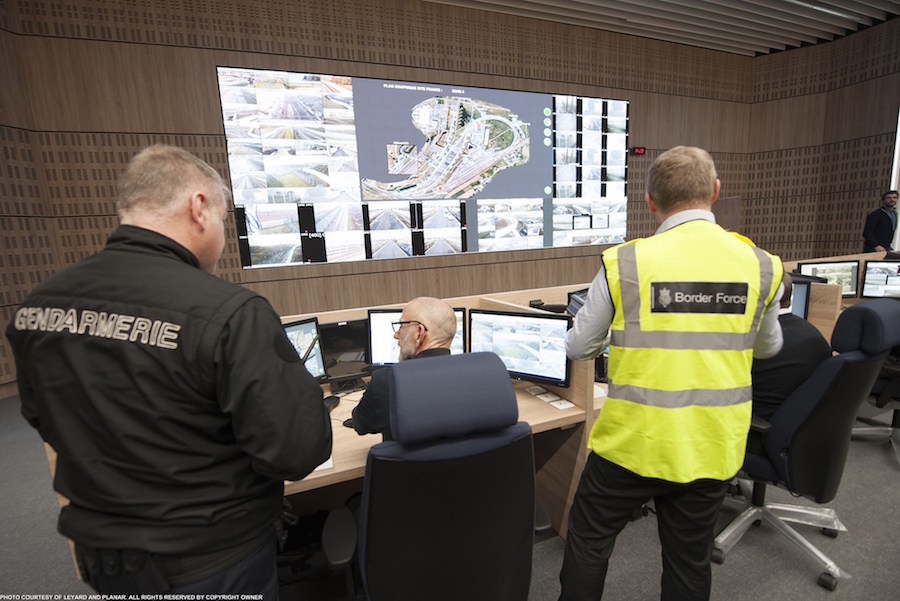Pictured: The Security Control Centre at the French terminal in Coquelles includes a 20sqm Leyard TWA Series LED, ultra-fine pixel pitch of 1.8mm video wall. Ask Jeff Von Horn, sales and engineering manager, and Joe Jackson, market manager of AVI-SPL’s Control Room Group what's the biggest AV game-changer for command and control rooms in 2018, and they both agree. “The biggest change I see is that direct view LED (DV LED) offerings from several big-name brands are becoming more prevalent and cost effective,” said Jackson. “This technology eliminates the bezel in traditional tiles or TVs in a video wall layout.”
Von Horn concurred and added more detail. “The current state of the art is 0.9 millimeter pixel pitch,” he said, “and then I have seen some below that.” A finer pixel pitch translates to better resolution but with an increase in cost. “Customers must consider the application for their design in order to determine which technology best suits their particular need,” added Jackson.
Compliance Matters
While there are various manufacturers producing DV LEDs, Van Horn explained, “we don't do much business with them if they're not TAA compliant,” something all government and some business clients require. The Trade Agreements Act (TAA) requires that the U.S. Government may acquire only U.S. made or designated country end products.
The Far Side
A finer pixel pitch means higher resolution and a higher cost. So why would a fine pixel pitch DV LED be useful for a video wall in a command and control center if operators are sitting several feet away? They wouldn’t necessarily need an ultra-fine pitch, so there would be a cost-savings if a video wall was spec’ed with 2.5 mm pitch (and everything in between).
But depending on an organization’s budget, future-proofing for higher resolution content is a reasonable consideration. “We're seeing a lot of partner activity with our wall processors supporting large LED wall applications,” said Bob Ehlers, VP of Business Development for RGB Spectrum. “Who would have ever thought that they would get so large, that 4K would blow up that large?”
One of the most obvious benefits a DV LED video wall is that it appears virtually seamless because the panels or tiles do not have bezels. Depending on the vendor, tiles can accommodate any size or shape wall, and they are not constrained to the shape a tiling of 16:9 panels would create. DV LEDs also have a high refresh rate, a wide color gamut, and they achieve “true black.”
Ehlers added, “When you have the luminosity, and a gigantic room with somebody sitting 100 feet away in the back of the room, and the screen size is so large, that 4K does still matter.”
The Near Side
Concurrent with the trend in fine pixel pitch is a dramatic decrease in the cost of 4K resolution monitors, which is helping operators in smaller command and control centers go UDH. “We're actually seeing designs now where people are coming to us and saying, ‘Well, I don't have a video wall, but I've got four workstations where I want wall functionality on those workstations,’” Ehlers relayed. A multi-windowed display on a larger format 4K display can supplant four 1080p monitors. "With OLED and MicroLED, and some of these new technologies coming along that have really true color depth and luminescence, to where you can go in and look at an image and see a black object in a black background, and discern it — it is pretty incredible.”
In applications such as video surveillance, Ehlers explained, “They use dynamic range (WDR) and are able to discern different light levels. So if I have a camera that's looking at a dark area, and I have dark objects moving through, now I can actually see it.” This type of clarity couldn’t be discerned with lower resolution displays. “The display technology keeping up with the image technology on the transmit end is enabling the use of high dynamic range (HDR),” he said. Optimizing luminescence and brighter colors is increasingly meaningful for commercial applications.
Where does 4K have the most impact right now? “On the desk, right in front of you, 4K matters probably the most,” Ehlers concluded. “But then when I get gigantic displays, 4K seems to be taking off.”
Cindy Davis is a contributing editor of AV Technology. Photography courtesy of Leyard and Planar.

